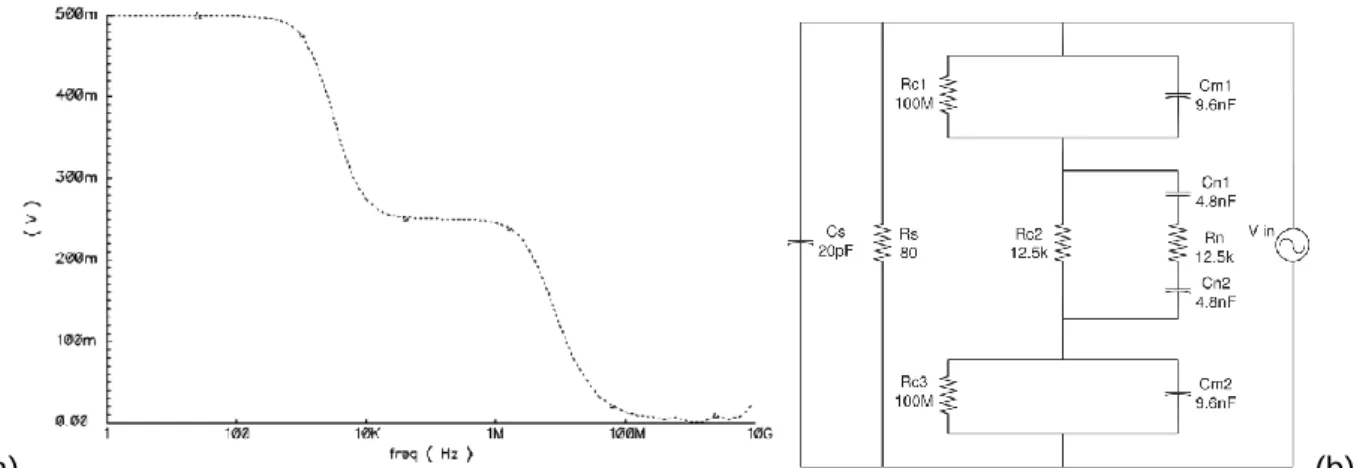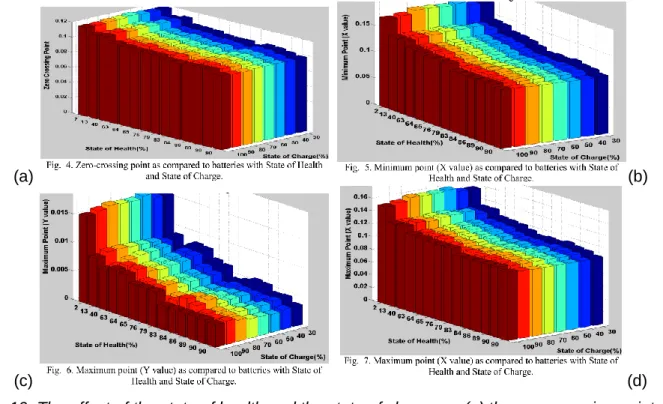ELECTROCHEMICAL IMPEDANCE SPECTROSCOPY AND ITS USE FOR TIME AND COST-EFFECTIVE
BATTERY-HEALTH-STATUS TESTING
Mihály Görbe*
Department of Science and Engineering, GAMF Faculty of Engineering and Computer Science, John von Neumann University, Kecskemét, Hungary
Keywords:
impedance spectroscopy electrochemical impedance spectroscopy
battery testing Article history:
Received 2018. September 7.
Revised 2018. November 3.
Accepted 2019. February 28.
Abstract
Impedance spectroscopy is the science of recording and evaluating the impedance of electrical circuit elements as the function of the exciting frequency. The electrical circuit elements can be virtually anything that can be excited by AC voltage sources (conventional discrete electric elements, battery cells and even biological tissues). As battery cells are electrochemical devices, studying them using impedance spectroscopy is electrochemical impedance spectroscopy (EIS). In this paper we provide a literature overview of impedance spectroscopy, and propose it as a measurement principle for the time- and cost- efficient state-of-health testing of individual Li-ion battery cells for the MegaLux solar vehicle racing team at our Faculty.
1 Introduction
In recent years, the student solar vehicle racing team “MegaLux” at John von Neumann University, GAMF Faculty of Engineering and Computer Science achieved several successes at the World Solar Challenge [1] (Fig. 1.).
Fig. 1. The MegaLux team poses after the successful arrival of the MegaLux solar vehicle at the finish, and winning the 3rd prize of the South African Solar Challenge 2016 in Cape Town
A typical racing solar vehicle uses a Li-ion battery pack to bridge solar energy production
Battery charging currents are conventionally measured in It or C units: both mean the current that, if could be supplied constantly, could deliver the battery’s nominal charge in 1 hour. As charging currents mostly range between a few tenths of C and a few C’s, full charge-discharge cycles can last several hours (see Fig. 2.). To test the SoH of several hundreds of batteries in an acceptable time using full charge-discharge cycles, unrealistically many parallel test pads must be used.
Fig. 2. Charge characteristics for Panasonic NCR18650B, the battery cell used in MegaLux vehicles [2]
My goal is to develop a SoH testing device for the MegaLux racing team, that tests the cells as fast as possible, and that is cost effective and simple enough, so that the team can afford and in- house built several of them, that ensures the possibility of parallel testing.
As the base principle I have chosen the impedance spectroscopy, and this paper is intended to be a review article on this topic especially in the application point of view.
2 Literature overview of impedance spectroscopy
Impedance spectroscopy is the science of recording and evaluating the impedance of electrical circuit elements as the function of the exciting frequency [3]. The recorded impedance values can be plotted on either Bode plots (impedance magnitude and phase angle as functions of exciting frequency), or on Nyquist plot (imaginary part as the function of real part, e.g. Figs 6,7,8.). In the latter case, although it is harder for the reader to recognize, what frequency a data point belongs to, the shape of the plot can tell the expert much qualitative information about the system under investigation (e.g. the approximate SoH of the battery, and in the case of defective battery, the defective part).
Quantitative evaluation of the data acquired is possible too, it mostly requires an equivalent circuit model of the system (e.g. Figs 3,4,6,7), whose circuit parameters can be fitted to be as close to the measured impedance data as possible.
The following examples represent the multitude of the application fields of impedance spectroscopy.
In order to develop medical diagnostic methods based on impedance spectroscopy, it is advantageous to understand the behavior difference between healthy and diseased cells. A simulated AC frequency response function of cells with nucleus can be seen on Fig. 3.a, while the corresponding equivalent circuit model is depicted on Fig. 3.b [4]. The electrical parameters of cell components characteristic to diseases can be determined empirically.
(a) (b) Fig. 3. (a) Simulated AC frequency response function of cells with nucleus (b) The corresponding
equivalent circuit model [4]
A simple medical application is the estimation of body water content and fat mass [5]. Body fat can be approximated as an insulator that does not contribute to the circuit model of the body (Fig. 4.a). Inside the fat-free regions of the body there is difference between the conducting path of low-frequency and high-frequency current. At low frequency the cell membranes block the current, only the intracellular liquid conducts, whereas at high frequency all liquid components conduct, serially connected by the capacitances of the cellular membranes (Fig. 4.b). There are diagnostic devices already commercially available (Fig. 4.c) that estimate body water content and/or fat mass using the impedance spectroscopy data and personal physical data (height, weight etc.) based on empirical equations.
(a) (b) (c)
Fig. 4. (a) Equivalent electrical circuit from the human body from the body water content and fat mass measuring point of view (b) Conducting paths in human non-fat tissues (c) The four-
electrodes circuit of the body water content and fat mass measurement [5]
It is possible to measure skin impedance spectra at different depths depending on combinations of electrodes at different distances. The system depicted on Fig. 5. works in the frequency range of 1 to 2.5 MHz, and the applied voltage/current is 150 mV/75 mA at maximum.
There are also studies regarding the relation of fruit quality and impedance spectra [7,8].
(a) (b)
Fig. 6. (a) Impedance spectra of unripe (●) and ripe (■) nectarine tissue, and a frozen and thawed tissue (▲). [7] (b) Equivalent electrical circuit model of a fruit. [8]
The investigation of batteries is also possible using impedance spectroscopy, moreover, it is possible to measure while not disturbing the DC (power) operation, at small alternating currents.
Several types of batteries have been investigated experimentally and using simulations of equivalent circuit models, now we cite only Li-ion batteries. Depending on battery type, the excitation frequency range typically extends from a few hundredths of Hz to a few kHz [3,5,9]. There are several equivalent circuit models of the Li-ion battery cell, one of them can be seen on Fig. 7, typical Nyquist plots are depicted on Figs 8 and 9.
Fig. 7. (a) An equivalent circuit of a Li-ion battery cell [5] (b) Definition of parameters of interest of Li-ion cell Nyquist plot [9]
Fig. 8. (a) An equivalent circuit of a Li-ion battery cell [5] (b) Definition of parameters of interest of Li-ion cell Nyquist plot [9]
The ageing of battery cells is a key process in capacity loss. In Fig 9. we can see, how ageing is reflected in the Nyquist plots of the impedance spectra.
Fig. 9. Evolution of Nyquist plots of a Li-ion battery cell while ageing [10]
It is worth investigating, if the computing effort of processing full spectral data series, and drawing conclusions from them can be reduced by characterizing the spectra by a few parameters of interest (for definitions see Fig. 8). In Fig. 10. the reflection of the state of health and the state of charge in the parameters of interest is depicted [9].
(a) (b)
(c) (d)
Fig. 10. The effect of the state of health and the state of charge on (a) the zero crossing point, (b) the x-minimum point, (c) the y-maximum point and (d) the x-maximum point.
According to the data on the figures, there is a strong correlation between the parameters of interest chosen and the electrochemical health of the battery.
In some circumstances ultra-low amplitude excitation may be necessary, which requires lock- in amplification before evaluation. At our Faculty there is knowledge of lock-in detection using low- cost (educational grade) DAQ-devices [11].
4 Conclusion
We have proposed a measurement principle for the cost- and time-efficient state-of-health testing of individual Li-ion battery cells for the MegaLux solar vehicle racing team at our Faculty. The new experimental device will also serve as basis of knowledge about battery defects, and new researches at material sciences.
Acknowledgment
This publication is supported by EFOP-3.6.1-16-2016-00006 ”The development and enhancement of the research potential at John von Neumann University” project. The Project is supported by the Hungarian Government and co-financed by the European Social Fund.
References
[1] https://www.worldsolarchallenge.org
[2] NCR18650B Standard data, Energy Company of Panasonic Group (2012) [3] Orazem, Tribollet, Electrochemical Impedance Spectroscopy, Wiley (2008)
[4] Ellappan, Sundararajan, A simulation study of the electrical model of a biological cell, Journal of Electrostatics 63 (2005) 297–307 (1-s2.0-S0304388604002141-main.pdf)
[5] Grossi, Riccò, EIS for biological analysis and food characterization, J. Sens. Sens. Syst. 6 (2017) 303–325 (jsss- 6-303-2017.pdf)
[6] Braun, Mangana, Goldinger, French, Dummer, Marghoob, Electrical Impedance Spectroscopy in Skin Cancer Diagnosis, Dermatol Clin 35 (2017) 489-493 (braun2017)
[7] Harker, Maindonald, Ripening of Nectarine Fruit, Plant Physiol. 106 (1994) 165-171 (1060165.pdf)
[8] Bauchot, The use of electrical impedance spectroscopy to assess the physiological condition of kiwifruit, Postharvest Biology and Technology 18 (2000) 9–18 (1-s2.0-S0925521499000563-main.pdf)
[9] Shabbir; Dunford; Shoa, State of Health Estimation of Li-Ion batteries using Electrochemical Impedance Spectroscopy, 2017 IEEE Transportation Electrification Conference and Expo (ITEC), Chicago (2017) 108-112 (shabbir2017.pdf)
[10] Jiang, Lin, Ju, Ma, Zheng, Wang, Electrochemical impedance spectra for lithium-ion battery ageing considering the rate of discharge ability, Energy Procedia 105 (2017) 844 – 849 (1-s2.0-S187661021730440X-main.pdf) [11] Kőházi-Kis, Phase-sensitive detection with a low cost DAQ USB device, Gradus, Vol 3, issue 1, ISSN 2064-8014
(2016)

![Fig. 2. Charge characteristics for Panasonic NCR18650B, the battery cell used in MegaLux vehicles [2]](https://thumb-eu.123doks.com/thumbv2/9dokorg/1079494.72767/2.892.272.630.215.447/fig-charge-characteristics-panasonic-ncr-battery-megalux-vehicles.webp)

